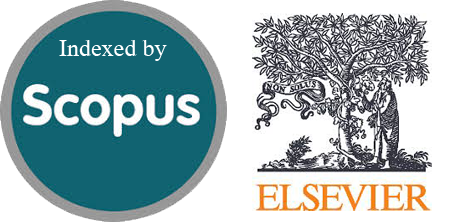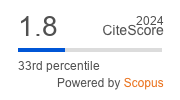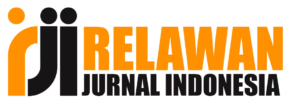Implementation of Word Recommendation System Using Hybrid Method for Speed Typing Website
Abstract
Typing is one of the most frequently done activities in society therefore a medium is necessary to help train typing words that are often mistyped. Methods used in this research are the Content-Based Filtering Algorithm to gather the words that have a similar pattern to the words that are often mistyped based on the user's previous typing records and the Collaborative Filtering Algorithm that uses other users typing pattern to recommend the words. The result of this study shows the Collaborative Filtering Algorithm was able to gather words that are hard to type by the user with an accuracy of 49.2%, dan the Collaborative Filtering able to predict the score on how difficult for the user to type a word with the result of Root Mean Square Error (RMSE) value of 0.82 and with the Root Mean Square Percentage Error (RMSPE) value of 30% from the actual value, and a website which is the combination of the two algorithms with the result of 28% of the total word that is recommended was indeed difficult to type by the user with the typing speed of 103 WPM, and 72.3% for the user that has a typing speed of 39 WPM.
Downloads
References
C.-H. Lin and E. Z.-F. Liu, “A Comparison between Drill-Based and Game-Based Typing Software,” in Transactions on Edutainment III, vol. 5940, Z. Pan, A. D. Cheok, W. Müller, and M. Chang, Eds. Berlin, Heidelberg: Springer Berlin Heidelberg, 2009, pp. 48–58. doi: 10.1007/978-3-642-11245-4_5.
A. Ikhsananto and S. Sutirman, “The Effectiveness of Rapid Typing Software and Module for Improving 10-Finger Typing Skills,” DP, vol. 13, no. 2, pp. 228–237, Dec. 2018, doi: 10.15294/dp.v13i2.15540.
H. S. Lestari, “INCREASE TYPING SPEED THROUGH DRILL METHOD,” p. 4, 2021.
M. W. Pamengas, T. Afirianto, and W. S. Wardhono, “Pengembangan Gim Edukasi Mengetik menggunakan Metode Touch-Typing untuk Meningkatkan Kecepatan Mengetik,” p. 8.
Z. Cui et al., “Personalized Recommendation System Based on Collaborative Filtering for IoT Scenarios,” IEEE Trans. Serv. Comput., vol. 13, no. 4, pp. 685–695, Jul. 2020, doi: 10.1109/TSC.2020.2964552.
C.-D. Wang, Z.-H. Deng, J.-H. Lai, and P. S. Yu, “Serendipitous Recommendation in E-Commerce Using Innovator-Based Collaborative Filtering,” IEEE Trans. Cybern., vol. 49, no. 7, pp. 2678–2692, Jul. 2019, doi: 10.1109/TCYB.2018.2841924.
Q. Zhang, L. Cao, C. Zhu, Z. Li, and J. Sun, “CoupledCF: Learning Explicit and Implicit User-item Couplings in Recommendation for Deep Collaborative Filtering,” in Proceedings of the Twenty-Seventh International Joint Conference on Artificial Intelligence, Stockholm, Sweden, Jul. 2018, pp. 3662–3668. doi: 10.24963/ijcai.2018/509.
S. M. Ali, G. K. Nayak, R. K. Lenka, and R. K. Barik, “Movie Recommendation System Using Genome Tags and Content-Based Filtering,” in Advances in Data and Information Sciences, vol. 38, M. L. Kolhe, M. C. Trivedi, S. Tiwari, and V. K. Singh, Eds. Singapore: Springer Singapore, 2018, pp. 85–94. doi: 10.1007/978-981-10-8360-0_8.
E. Uko, B. O., and P. O., “An Improved Online Book Recommender System using Collaborative Filtering Algorithm,” IJCA, vol. 179, no. 46, pp. 41–48, Jun. 2018, doi: 10.5120/ijca2018917193.
J. Lee, M. Sun, and G. Lebanon, “A Comparative Study of Collaborative Filtering Algorithms,” arXiv:1205.3193 [cs, stat], May 2012, Accessed: Oct. 26, 2021. [Online]. Available: http://arxiv.org/abs/1205.3193
M. Benard Magara, S. O. Ojo, and T. Zuva, “A comparative analysis of text similarity measures and algorithms in research paper recommender systems,” in 2018 Conference on Information Communications Technology and Society (ICTAS), Durban, Mar. 2018, pp. 1–5. doi: 10.1109/ICTAS.2018.8368766.
Y. Deldjoo, M. Elahi, P. Cremonesi, F. Garzotto, P. Piazzolla, and M. Quadrana, “Content-Based Video Recommendation System Based on Stylistic Visual Features,” J Data Semant, vol. 5, no. 2, pp. 99–113, Jun. 2016, doi: 10.1007/s13740-016-0060-9.
S. Reddy, S. Nalluri, S. Kunisetti, S. Ashok, and B. Venkatesh, “Content-Based Movie Recommendation System Using Genre Correlation,” in Smart Intelligent Computing and Applications, vol. 105, S. C. Satapathy, V. Bhateja, and S. Das, Eds. Singapore: Springer Singapore, 2019, pp. 391–397. doi: 10.1007/978-981-13-1927-3_42.
M. Phanich, P. Pholkul, and S. Phimoltares, “Food Recommendation System Using Clustering Analysis for Diabetic Patients,” in 2010 International Conference on Information Science and Applications, Seoul, Korea (South), 2010, pp. 1–8. doi: 10.1109/ICISA.2010.5480416.
T. V. Yadalam, V. M. Gowda, V. S. Kumar, D. Girish, and N. M, “Career Recommendation Systems using Content based Filtering,” in 2020 5th International Conference on Communication and Electronics Systems (ICCES), COIMBATORE, India, Jun. 2020, pp. 660–665. doi: 10.1109/ICCES48766.2020.9137992.
P. B.Thorat, R. M. Goudar, and S. Barve, “Survey on Collaborative Filtering, Content-based Filtering and Hybrid Recommendation System,” IJCA, vol. 110, no. 4, pp. 31–36, Jan. 2015, doi: 10.5120/19308-0760.
“Indonesian Adjective Sentiment (Kata Sifat).” https://www.kaggle.com/datasets/linkgish/indonesian-adjective-sentiment-kata-sifat (accessed Aug. 14, 2022).
“Speed Check.” https://speed-check.netlify.app/ (accessed Aug. 14, 2022).
D. K. Lee, J. In, and S. Lee, “Standard deviation and standard error of the mean,” Korean J Anesthesiol, vol. 68, no. 3, p. 220, 2015, doi: 10.4097/kjae.2015.68.3.220.
E. H. Livingston, “The mean and standard deviation: what does it all mean?,” Journal of Surgical Research, vol. 119, no. 2, pp. 117–123, Jun. 2004, doi: 10.1016/j.jss.2004.02.008.
S. Qaiser and R. Ali, “Text Mining: Use of TF-IDF to Examine the Relevance of Words to Documents,” IJCA, vol. 181, no. 1, pp. 25–29, Jul. 2018, doi: 10.5120/ijca2018917395.
A. A. Hakim, A. Erwin, K. I. Eng, M. Galinium, and W. Muliady, “Automated document classification for news article in Bahasa Indonesia based on term frequency inverse document frequency (TF-IDF) approach,” in 2014 6th International Conference on Information Technology and Electrical Engineering (ICITEE), Yogyakarta, Indonesia, Oct. 2014, pp. 1–4. doi: 10.1109/ICITEED.2014.7007894.
P. Bafna, D. Pramod, and A. Vaidya, “Document clustering: TF-IDF approach,” in 2016 International Conference on Electrical, Electronics, and Optimization Techniques (ICEEOT), Chennai, India, Mar. 2016, pp. 61–66. doi: 10.1109/ICEEOT.2016.7754750.
J. chiang, “Overview of Item-Item Collaborative Filtering Recommendation System,” Geek Culture, May 30, 2021. https://medium.com/geekculture/overview-of-item-item-collaborative-filtering-recommendation-system-64ee15b24bb8 (accessed Aug. 24, 2022).
Copyright (c) 2023 Jurnal RESTI (Rekayasa Sistem dan Teknologi Informasi)

This work is licensed under a Creative Commons Attribution 4.0 International License.
Copyright in each article belongs to the author
- The author acknowledges that the RESTI Journal (System Engineering and Information Technology) is the first publisher to publish with a license Creative Commons Attribution 4.0 International License.
- Authors can enter writing separately, arrange the non-exclusive distribution of manuscripts that have been published in this journal into other versions (eg sent to the author's institutional repository, publication in a book, etc.), by acknowledging that the manuscript has been published for the first time in the RESTI (Rekayasa Sistem dan Teknologi Informasi) journal ;








